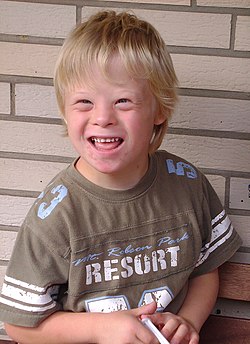ਡਾਊਨ ਸਿੰਡਰੋਮ (ਡੀ.ਐਸ. ਜਾਂ ਡੀ. ਐਨ.ਐਸ.), ਨੂੰ ਟ੍ਰਾਈਸੋਮੀ 21 ਨਾਂ ਨਾਲ ਵੀ ਜਾਣਿਆ ਜਾਂਦਾ ਹੈ, ਇੱਕ ਜੈਨੇਟਿਕ ਡਿਸਰਡਰ ਹੈ ਜੋ ਕਿ ਕ੍ਰੋਮੋਸੋਮ 21 ਦੀ ਤੀਜੀ ਕਾਪੀ ਜਾਂ ਇੱਕ ਹਿੱਸੇ ਦੇ ਕਾਰਨ ਹੈ।[ 2] [ 1] [ 7]
ਡਾਊਨ ਸਿੰਡਰੋਮ ਮਨੁੱਖਾਂ ਵਿੱਚ ਸਭ ਤੋਂ ਆਮ ਕ੍ਰੋਮੋਸੋਮ ਸਬੰਧੀ ਅਸਧਾਰਨਤਾਵਾਂ ਵਿੱਚੋਂ ਇੱਕ ਹੈ।[ 7] [ 1] [ 9] [ 10] [ 11] [ 12] [ 13] [ 12]
ਡਾਊਨ ਸਿੰਡਰੋਮ ਵਾਲੇ ਬੱਚੇ ਦੇ ਚਿਹਰੇ ਦੀਆਂ ਵਿਸ਼ੇਸ਼ਤਾਵਾਂ ਦਾ ਡਰਾਇੰਗ ਡਾਊਨ ਸਿੰਡਰੋਮ ਦੀ ਬਿਮਾਰੀ ਨਾਲ ਪੀੜਤ ਇੱਕ ਅੱਠ ਸਾਲ ਦਾ ਲੜਕਾ ਡਾਊਨ ਸਿੰਡਰੋਮ ਵਾਲੇ ਲੋਕਾਂ ਵਿੱਚ ਹਮੇਸ਼ਾ ਭੌਤਿਕ ਅਤੇ ਬੌਧਿਕ ਅਪਾਹਜਤਾਵਾਂ ਹੁੰਦੀਆਂ ਹਨ।[ 14] [ 7] [ 15] [ 8]
ਲੱਛਣ
ਪ੍ਰਤੀਸ਼ਤਤਾ
ਲੱਛਣ
ਪ੍ਰਤੀਸ਼ਤਤਾ
Mental impairment
99%[ 16]
Abnormal teeth
60%[ 17]
Stunted growth
90%[ 18]
Slanted eyes
60%[ 15]
Umbilical hernia
90%[ 19]
Shortened hands
60%[ 17]
Increased skin on back of neck
80%[ 12]
Short neck
60%[ 17]
Low muscle tone
80%[ 20]
Obstructive sleep apnea
60%[ 12]
Narrow roof of mouth
76%[ 17]
Bent fifth finger tip
57%[ 15]
Flat head
75%[ 15]
Brushfield spots in the iris
56%[ 15]
Flexible ligaments
75%[ 15]
Single transverse palmar crease
53%[ 15]
Proportionally large tongue[ 21]
75%[ 20]
Protruding tongue
47%[ 17]
Abnormal outer ears
70%[ 12]
Congenital heart disease
40%[ 17]
Flattened nose
68%[ 15]
Strabismus
~35%[ 1]
Separation of first and second toes
68%[ 17]
Undescended testicles
20%[ 22]
↑ 1.0 1.1 1.2 1.3 1.4 Weijerman, ME; de Winter, JP (Dec 2010). "Clinical practice. The care of children with Down syndrome" . European Journal of Pediatrics . 169 (12): 1445–52. doi :10.1007/s00431-010-1253-0 . PMC 2962780 PMID 20632187 . ↑ 2.0 2.1 Patterson, D (Jul 2009). "Molecular genetic analysis of Down syndrome". Human Genetics . 126 (1): 195–214. doi :10.1007/s00439-009-0696-8 . PMID 19526251 . ↑ ਹਵਾਲੇ ਵਿੱਚ ਗ਼ਲਤੀ:Invalid <ref> tag; no text was provided for refs named Mor2002
↑ ਹਵਾਲੇ ਵਿੱਚ ਗ਼ਲਤੀ:Invalid <ref> tag; no text was provided for refs named NIH2014Diag
↑ ਹਵਾਲੇ ਵਿੱਚ ਗ਼ਲਤੀ:Invalid <ref> tag; no text was provided for refs named Roi2003
↑ ਹਵਾਲੇ ਵਿੱਚ ਗ਼ਲਤੀ:Invalid <ref> tag; no text was provided for refs named NADS
↑ 7.0 7.1 7.2 7.3 Malt, EA; Dahl, RC; Haugsand, TM; Ulvestad, IH; Emilsen, NM; Hansen, B; Cardenas, YE; Skøld, RO; Thorsen, AT (Feb 5, 2013). "Health and disease in adults with Down syndrome". Tidsskrift for den Norske Laegeforening: Tidsskrift for Praktisk Medicin, NY Raekke . 133 (3): 290–94. doi :10.4045/tidsskr.12.0390 . PMID 23381164 . ↑ 8.0 8.1 Kliegma, Robert M. (2011). "Down Syndrome and Other Abnormalities of Chromosome Number". Nelson textbook of pediatrics ISBN 978-1-4377-0755-7 ↑ 9.0 9.1 GBD 2015 Disease and Injury Incidence and Prevalence, Collaborators. (8 October 2016). "Global, regional, and national incidence, prevalence, and years lived with disability for 310 diseases and injuries, 1990–2015: a systematic analysis for the Global Burden of Disease Study 2015" . Lancet . 388 (10053): 1545–1602. doi :10.1016/S0140-6736(16)31678-6 . PMC 5055577 PMID 27733282 . CS1 maint: numeric names: authors list (link ) ↑ 10.0 10.1 GBD 2015 Mortality and Causes of Death, Collaborators. (8 October 2016). "Global, regional, and national life expectancy, all-cause mortality, and cause-specific mortality for 249 causes of death, 1980–2015: a systematic analysis for the Global Burden of Disease Study 2015" . Lancet . 388 (10053): 1459–1544. doi :10.1016/s0140-6736(16)31012-1 . PMC 5388903 PMID 27733281 . CS1 maint: numeric names: authors list (link ) ↑ GBD 2013 Mortality and Causes of Death, Collaborators (17 December 2014). "Global, regional, and national age-sex specific all-cause and cause-specific mortality for 240 causes of death, 1990–2013: a systematic analysis for the Global Burden of Disease Study 2013" . Lancet . 385 (9963): 117–71. doi :10.1016/S0140-6736(14)61682-2 . PMC 4340604 PMID 25530442 . CS1 maint: numeric names: authors list (link ) ↑ 12.0 12.1 12.2 12.3 12.4 Hickey, F; Hickey, E; Summar, KL (2012). "Medical update for children with Down syndrome for the pediatrician and family practitioner". Advances in Pediatrics . 59 (1): 137–57. doi :10.1016/j.yapd.2012.04.006 . PMID 22789577 . ↑ Evans-Martin, F. Fay (2009). Down syndrome ISBN 978-1-4381-1950-2 ↑ Faragher, edited by Rhonda; Clarke, Barbara (2013). Educating Learners with Down Syndrome Research, theory, and practice with children and adolescents ISBN 978-1-134-67335-3 the original on 2017-01-23. ↑ 15.0 15.1 15.2 15.3 15.4 15.5 15.6 15.7 Hammer, edited by Stephen J. McPhee, Gary D. (2010). "Pathophysiology of Selected Genetic Diseases". Pathophysiology of disease: an introduction to clinical medicine (6th ed.). New York: McGraw-Hill Medical. pp. Chapter 2. ISBN 978-0-07-162167-0 CS1 maint: multiple names: authors list (link ) ↑ Sankar, editors John M. Pellock, Blaise F.D. Bourgeois, W. Edwin Dodson; associate editors, Douglas R. Nordli, Jr., Raman (2008). Pediatric epilepsy diagnosis and therapy ISBN 978-1-934559-86-4 the original on 2017-01-23. CS1 maint: multiple names: authors list (link ) ↑ 17.0 17.1 17.2 17.3 17.4 17.5 17.6 Epstein, Charles J. (2007). The consequences of chromosome imbalance: principles, mechanisms, and models ISBN 978-0-521-03809-6 the original on 2017-01-23. ↑ Daniel Bernstein (2012). Pediatrics for medical students ISBN 978-0-7817-7030-9 the original on 2017-01-23. ↑ Tecklin, Jan S. (2008). Pediatric physical therapy ISBN 978-0-7817-5399-9 the original on 2017-01-23. ↑ 20.0 20.1 Domino, edited by Frank J. (2007). The 5-minute clinical consult 2007 ISBN 978-0-7817-6334-9 the original on 2017-01-23. ↑ Perkins, JA (December 2009). "Overview of macroglossia and its treatment". Current Opinion in Otolaryngology & Head and Neck Surgery . 17 (6): 460–65. doi :10.1097/moo.0b013e3283317f89 . PMID 19713845 . ↑ Wilson, Golder N.; Cooley, W. Carl (2006). Preventive management of children with congenital anomalies and syndromes ISBN 978-0-521-61734-5 the original on 2017-01-23.
















